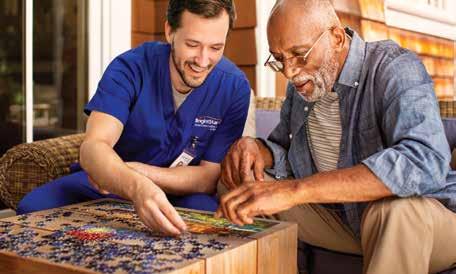
11 minute read
Basques on the Western Slope
Discover a higher standard of home care.
• Companion & personal care • Specially trained caregivers • No minimum hours
Advertisement
Call for your free in-home assessment. 970-628-1241
brightstarcare.com/grand-junction-montrose
©BrightStar Care Independently Owned and Operated
MONDAY - THURSDAY 3-5 PM
Early Dine
HAPPY HOUR 4-6
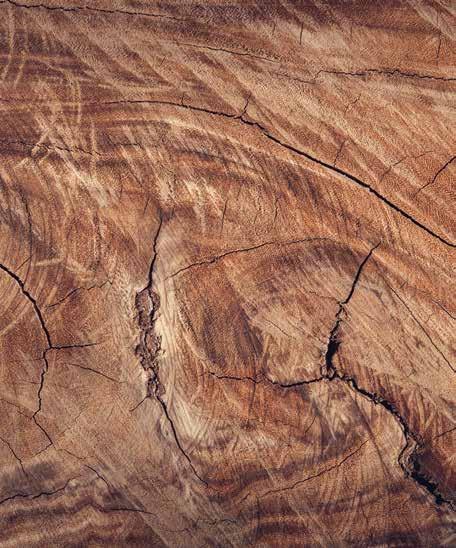
7 Days A Week
$3.50 domestic pints $4.75 premium pints
$1199 FOR
11CHOOSE FROM
Grilled BBQ Chicken
DINNERS
6 oz. Sirloin
-THELegenD
MARGARITA
Call Ahead Seating 970-243-5700
Basques of Western Colorado
How the culture influenced the Grand Valley and beyond
By Joaquin Garcia
The epic clash of two dynamic rivers on the western slope of the majestic Rocky Mountains is the epicenter of historic Colorado Basque culture. Names like Etchart, Arrayet, Azcarraga, Celayeta and Gorrino are original immigrants or descendants of the Basques who settled in Grand Junction. Basques also established themselves nearby in Montrose, Rifle, Meeker and Craig.
These proud and hard-working Vasco settlers were mostly sheepherders, but a few non-claustrophobic souls were miners as well. Basque settlers were drawn to the fertile land where the Colorado and Gunnison rivers meet. Local Basques would winter their flocks in Utah’s southern stretches, then drive the bleating wooly creatures to the high mountains of western Colorado each summer.
NOTABLE BASQUES
Locally, two of the most wellknown sheepmen were Jean Urruty and Emmett Elizondo, who were originally from Iparralde (northern Basque country in France) and Hegoalde (southern Basque country in Spain).
Urruty was the most culturally influential of the two and became affluent when oil was discovered on his ranch property.
In the 1960s and 1970s, he was the driving force in promoting Basque ethos in Colorado. He even starred as himself in an independent movie titled, “The Basque Sheepherder.”
An expert blacksmith, Urruty decorated his home with artwork fashioned from wrought iron. He and his wife, Benny, represented Colorado in NABO’s (North American Basque Organizations) early stages. Further, he donated several acres of land on his farm near 24 and G Roads for a Basque Club.
Another notable Colorado Basque is Emmett Elizondo, who at one time was probably the wealthiest rancher in the state. At the peak of his empire, he ran 30,000 head and later added cattle to the mix.
He helped develop the Fruita State Bank and served as its president for many years. Unfortunately, when Elizondo died in 1992, the livestock and holdings were sold to non-Basque, out-of-state ranchers.
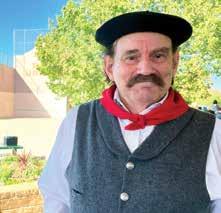
Joaquin Garcia stands outside the Plaza Urrutia, the pelota handball court in Canyon View Park
BUILDING COMMUNITY
Boarding houses played an important role in early Basque-American history. Known to Basques as “ostatuak” or “hotelak,” these establishments provided a home away from home for Basques just arriving and a room for the traveling sheepherder when he wasn’t tending the flock.
Grand Junction had two boarding houses that catered to Basques. One was the Cantebarria, which was located downtown and opened in 1919. It had a player piano which was
Bare-handed handball known as “pelota” is an integral part of the Basque culture. Pelota frontons (courts) were erected in many Basque communities, including Grand Junction. Last month, Basques from all over the state gathered at the Plaza Urrutia in Canyon View Park for a barbecue picnic and pelota demonstration.

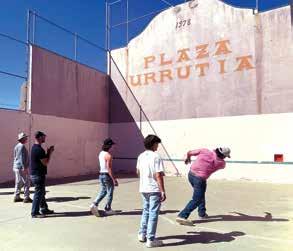

purchased in 1920 for $2,000—a small fortune. The other boardinghouse opened in 1936 and was located at 234 Ute Ave.
Both establishments closed in 1946, creating a state of affairs where the sense of the Basque community was gone.
PRESERVING HERITAGE
Bare-handed handball known as “pelota” is an integral part of the Basque culture. The sport originated from the medieval game jeu de paume ,and was developed by the Basques into the modern game which has a dozen or so variations.
Pelota frontons (handball courts) were erected in many Basque communities, including Grand Junction.
Urruty constructed a fronton on the land he donated to the Basque club, which is now part of Canyon View Park. The club was instrumental in organizing parties and pelota matches at the site for years. After Urruty died in 1983, the handball court was sold to the City.
In the 1990s, the City placed a “no trespassing” sign and the court was neglected. In 1999, City officials announced they were going to demolish the court and construct a parking lot in its place.
Basque residents rose up to protect a symbol of their history and tradition. They raised a considerable amount of money to finance their cause and the City finally relented.
The court was subsequently restored with reinforced walls and a new floor. Trees and shrubs were planted, a picnic area was added and the renovated Plaza Urrutia was presented to the community with a ribbon-cutting ceremony in October 2003.
Today, the Colorado Basque community is made up of children and grandchildren of local sheepherders, along with those who were born and raised in Euskal Herria, the Basque country that straddles the border between France and Spain.
Many local Basques, along with those who can trace their ancestry back hundreds of years to Euskal Herria, are active members of Colorado Euskal Etxea, a Denver-based nonprofit Basque club. This small but active club hosts several annual celebrations and various cultural events across the state.
In September, hundreds of club members and Basque supporters gathered at the Plaza Urrutia at Canyon View Park for a pelota demonstration by professional players from San Francisco.
“The city hasn’t experienced a formal pelota event of this historical significance since 1979 when a contingent from the Basque country visited Grand Junction,” according to a Colorado Euskal Etxea press release.
For more information about Colorado Euskal Etxea and local Basque culture, visit www.coloetxea.wixsite. com/coloradoeuskaletxea or call 303-868-0906. ■

Liveastress-freelifestyle inyour goldenyears!
NEED todownsize toasmallerhome
DECIDE itis timeforchange
CONSULT a TrustedSeniorAdvisor

Senior Real Estate Specialist SeniorRealEstateSpecialist Senior Real Estate Specialist SeniorRealEstateSpecialist
Come experience the Eagle Ridge
• Post Physical,
Occupational, and Speech
Therapies • Life Enrichment
Programs Seven
Days A Week • Short and Long
Term Care • 24-Hour Skilled
Nursing Care • Hospice Care • Respite Care
OPENINGS NOW AVAILABLE!
Call today and talk with one of our Professional Care Experts! 970-243-3381
2425 Teller Avenue | Grand Junction, CO 81501 www.vivage.com/eagleridge
Denver Fairmount Cemetery tour offers splendor and history
By Steve Strickland
Cemeteries get a bad rap, especially this time of year. Though they’re often depicted in a creepy way in decorations or horror movies, the reality is far from scary. They’re fascinating!
As a monument industry worker, I have visited dozens of cemeteries in Colorado, from forlorn prairie cemeteries and well-kept cremation gardens to picturesque mountain graveyards overrun with glorious wildflowers. All hold their own unique beauty, charms and stories.
But Denver’s Fairmount Cemetery is head and shoulders above the rest when it comes to the sheer volume of granite, the masterful workmanship and the epic history it contains. The affluence and opulence of Denver’s movers, shakers and ordinary well-to-do of all decades is on enduring display in this magnificent garden of history. CEMETERY TOURS
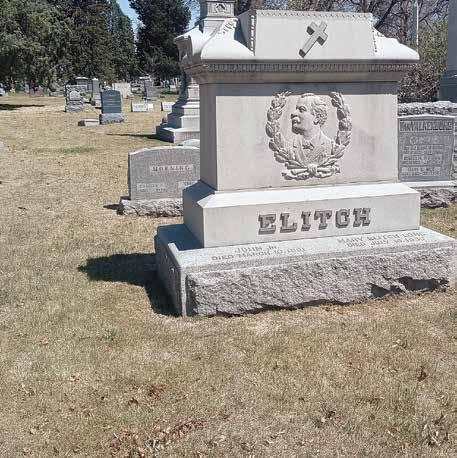
Fairmount was established in 1890, a mere 32 years after Denver was founded, and is still used as a burial ground today.
Fairmount Cemetery’s professionally guided tours are offered by the Fairmount Heritage Foundation. Seasoned actors guide around two dozen paying customers at a time through the tombstones and monuments of a dozen prominent names and families from Denver’s earliest days. Tours last an hour and a half and are 1.5-2 miles in distance at an easy pace. Fully charged scooters and power wheelchairs can easily traverse the grounds.
THE “GOOD OL’ DAYS”
From the first family monument described on the tour to the last, the magnificence and artistic detail is astounding. Professional narrators tell of the dramatic lives of families during the Edwardian and surrounding eras, including romances, divorces, affairs, murders and bitter family fortune feuds.
Horrific crimes, mysteries and injustices have been laid to rest as well in Fairmount. Twelve-year-old Louise Frost was raped, stomped on and stabbed on the outskirts of Limon in 1900. She died shortly
World Class Spinal Care Dr. J. Alex Sielatycki
Spine Surgeon
•Highest commitment to excellence in patient care. •Focuses on surgical motion preservation in both the cervical and lumbar spine. •Considers spinal fusion only as last-resort when motion preservation is not possible.
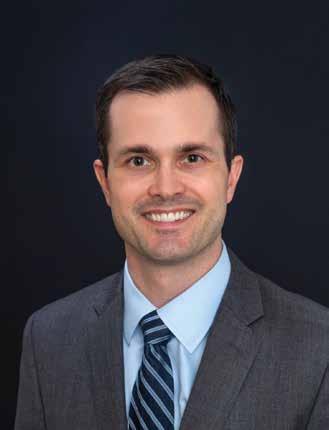
Get back to living the life you love.
Compassionate, Effective Orthopedic Care 100 Pioneers Medical Center Drive | Meeker, CO 81641 | 970.878.9752 www.coloradoadvancedorthopedics.com
COLORADO ADVANCED ORTHOPEDICS
SPORTS MEDICINE & SPINE
after this brutal attack and was buried in Fairmount, reportedly in the same grave as her 2-year-old sister.
Compounding the shock and cruelty of this incident, what passed for an investigation in those days resulted in the arrest of a young Black man who was, quite possibly, not guilty. Even when the railroad laborer had his defenders, which included a detective. Without a trial, however, Preston Porter Jr., age 16, was burned alive by an outraged mob on the prairie near the scene of the crime. This act of lawless vengeance caused a national uproar.
Fifty-five years later, a massive, well-funded justice system featuring groups of forensic scientists was in charge of the region when a luxurious DC-6B left Denver’s Stapleton Airport and crashed near Longmont. All 44 passengers and crew were killed, including the wife of an assistant to President Eisenhower.
Within a few weeks, FBI investigators and aviation authorities reassembled the wreckage and determined that a time bomb in the luggage storage section caused the disaster. Investigators used evidence from the wreckage to swiftly focus on a suspect: Jack Gilbert Graham, the son of Daisie E. (Walker) King, a woman whose suitcase had evidently carried the bomb.
Graham had a history of arson, violence and attempted insurance fraud stunts. He was executed in a state-of-the-art gas chamber less than two years after the explosion. Walker-King is also buried in Fairmount. The headline of her modest marker simply reads “Walker.”
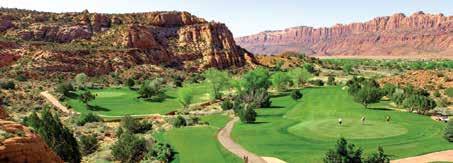
BURIED BENEFACTORS

Though it may seem that Fairmount’s elaborate monuments are some indication of roaring economic excess, many of the prominent individuals buried there “gave as good as they got.”
They were generous donors, visionaries and benefactors in their community. Iliff, Speer, Bonfils, Clayton, Moffat, Cheeseman and Brown are just a few of the noteworthy names and examples of noble, intrepid, hard-working and conscientious wealthy and otherwise fortunate philanthropists. These surnames have earned their places on avenues, colleges, parks, tunnels, streets and foundations.
WAR HEROES
Fairmount Cemetery contains four distinct areas and monuments dedicated to war heroes. A magnificent bronze statue of a soldier, perched high on a granite and bronze marker, is dedicated to volunteers. Soldiers’ graves appear to radiate outward from this stately tower, bearing the names of veterans from the Spanish-American War, the Civil War and peacetime soldiers who served up to the beginning of World War I.
Lieutenant Francis Brown Lowry, depicted in bronze, looks toward the graves of many World War I veterans in the area, including actual members of his battalion, as though he were still addressing or commanding them.
Lowry was the first Colorado pilot killed in World War I. Military airfields in Colorado were named after the war hero starting in 1924, including the Lowry Air Force Base which operated from 1938 to 1994.
In the Garden of Honor, the marble GI gravestones are arranged in another concentric formation, facing a flagpole flying the American flag. The Nisei War Memorial honors more than 30,000 courageous Japanese Americans who served in World War II and the Korean War.
A map of Fairmount Cemetery reveals an overlapping and almost spontaneous pattern of sections and driveways. Any journey through this vast and imposing cemetery is bound to yield intriguing discoveries, as well as “six degrees of separation” links that morph fluidly into more branches on the evolving family tree, or however you choose to interpret the meaningful lives memorialized there. ■
Sometimes we all need a little help caring for a loved one

Dementia & Alzheimer’s Care
Hilltop’s Senior Daybreak is a unique day program that keeps seniors with memory loss safe and active while providing their caregivers the flexibility and support they need to care for their loved ones at home. We also offer valuable information and support groups specifically designed for those caring for someone affected by dementia and Alzheimer’s. Call (970) 241-7798
seniordaybreak.org
LOCALLY OWNED AND OPERATED BY HILLTOP
Golf Amidst the Beautiful Red Rocks of Moab
18 holes carved out of the high desert landscape
Four sets of tees to accommodate golfers of ALL skill levels! Full-Service Pro Shop Lessons • Par 72
Moab Golf Course
Call today to book your tee time 435-259-6488
2705 S. East Bench Road • Moab, UT • moabgolfcourse.com
Wake up with beautiful
MICROBLADING!Transform your brows with
BEFORE AFTER




